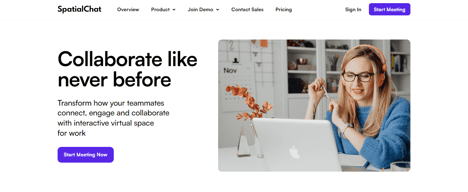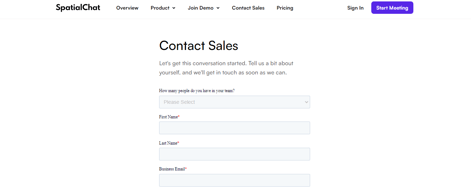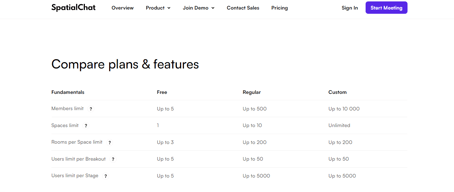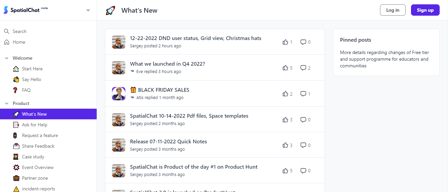

Unclaimed: Are are working at SpatialChat ?
SpatialChat Reviews & Product Details

| Segment |
|
|---|---|
| Deployment | Cloud / SaaS / Web-Based |
| Support | 24/7 (Live rep), Chat, Email/Help Desk, FAQs/Forum, Knowledge Base, Phone Support |
| Training | Documentation |
| Languages | English |






Compare SpatialChat with other popular tools in the same category.

the incredible flexibility of customizing your space. It creates a really warm environment to foster connection,
Nothing yet. 8-). Thank you for listening to your users and adjusting features at a fast pace.
it helps me create a warm environment for my coaching and facilitation projects.
O spatial chat é uma plataforma excelente para dar aulas de forma interativa, rápida e usando muitos recursos visuais. Acredito que a maior vantagem é a de ser gratuito e ter a possibilidade de se afastar e diminuir o som de forma rápida e funcional.
O spatial chat é uma plataforma muito intuitiva e fácil acesso. entretanto, passei por problemas para ligar minha câmera do celular e em algumas reuniões, as pessoas não conseguiam ligar os microfones.
O spatial chat me ajudou muito na didática de aulas, onde nas outras plataformas não era possivel gratuitamente e de forma funcional trabalhar em duplas com os estudantes.
It is such a different platform to the typical zoom conferences, meet, etc. that participants enter with a different attitude and good disposition. The onboarding is so easy that anyone can participate and enjoy it for the first moment. It's an incredible experience and makes people feel closer in this virtuality living. We have used it to dance, to play games, to chat as if you were in a bar.
I would like to have some ideas or examples for interactions. Sometimes I think I'm not taking advantage of the full potential the platform has. Maybe something i don´t like its that to share a screen its a bit complicated. Another thing can be the prize, that for some countries and in our case it's expensive to afford it if you are planning to do something for a large amount of people.
The main problem it solves is the lack of face-to-face experiences and networking or after-party due to the pandemic. Other problem that Spatial solves, its when you need to facilitate dynamics with more than one team at the same time.
SpatialChat brings back some lost spontaneity in online meetings. It's also very easy to use !!!
The max not of 50 persons could hypothetically cause problems
We used SpatialChat to complement the classic online meeting tools in the frame of an online conference - It really felt like being in the lobby of conference - approaching people - and e - meeting colleagues in a secure but informal way as well
What all you get without making us pay is astonishing
It takes a minute to get down navigating. It's simple for the tech savvy and may be a challenge for the dinosaurs out there
Designing the layout skillfully will prevent hiccups and practicing with other teachers before executing to assess user friendliness and minimize lesson plan flaws
Very interactive, looking cool, super user friendly and great functionalities to create your own look and feel.
As a speaker, it is a 'must' to have double screens in order to see both presentation as well as the responses in the (break out) room. Not all speakers have these facilities.
.
My clients and attendees love that they're able to skip to download headache that comes along with other platforms. Onboarding is SO easy. Another highlight is the multiple ways to share content - design assets, videos, gifs, etc. is becoming increasingly important to brands and we're happy to offer SpatialChat as a resolution. Lastly - SpatialChat is always adding new features, making it one of my agency's most dynamic platforms to offer.
We haven't experienced many glitches, especially since attendees check their audio + video before entering the platform, but there is a concern of live support if any issues do arise. A lot of our events are international with off times, so that's something we'll need to explore a resolution for. Additionally, more onboarding notes within the platform throughout the experience would help the event team with questions along the way such as "how do we move around again?" "why can't I hear this attendee?" etc. Not a dislike, but would love to see this platform grow to offer microsite capabilities, registration and more.
Web-based AND face-to-face networking is a major win for our team and clients. We want to make the attendee experience totally effortless, and SpatialChat truly focuses on getting attendees into the platform and engaging as fast as possible. SpatialChat also helps us offer a holistic experience - we have control over design, music, speaker management, etc.
Exactly the same experience as an actual event. Easy to use, very intuitive look and feel.
Asian language support could be a bit better but it's good enough already.
To host hybrid event during C-19.
The variety and flexibility of meeting rooms and interactions.
During conversations the profile bubbles are a bit too small.
People new to tech like to use something fun and innovative.
Stable video and audio, works on all major browsers, even mobile is supported.
Slows down when to many things get pinned in a room. More granular permission would help here.
Networking at virtual conferences and even scientific poster displays.









